Page 379 of 720
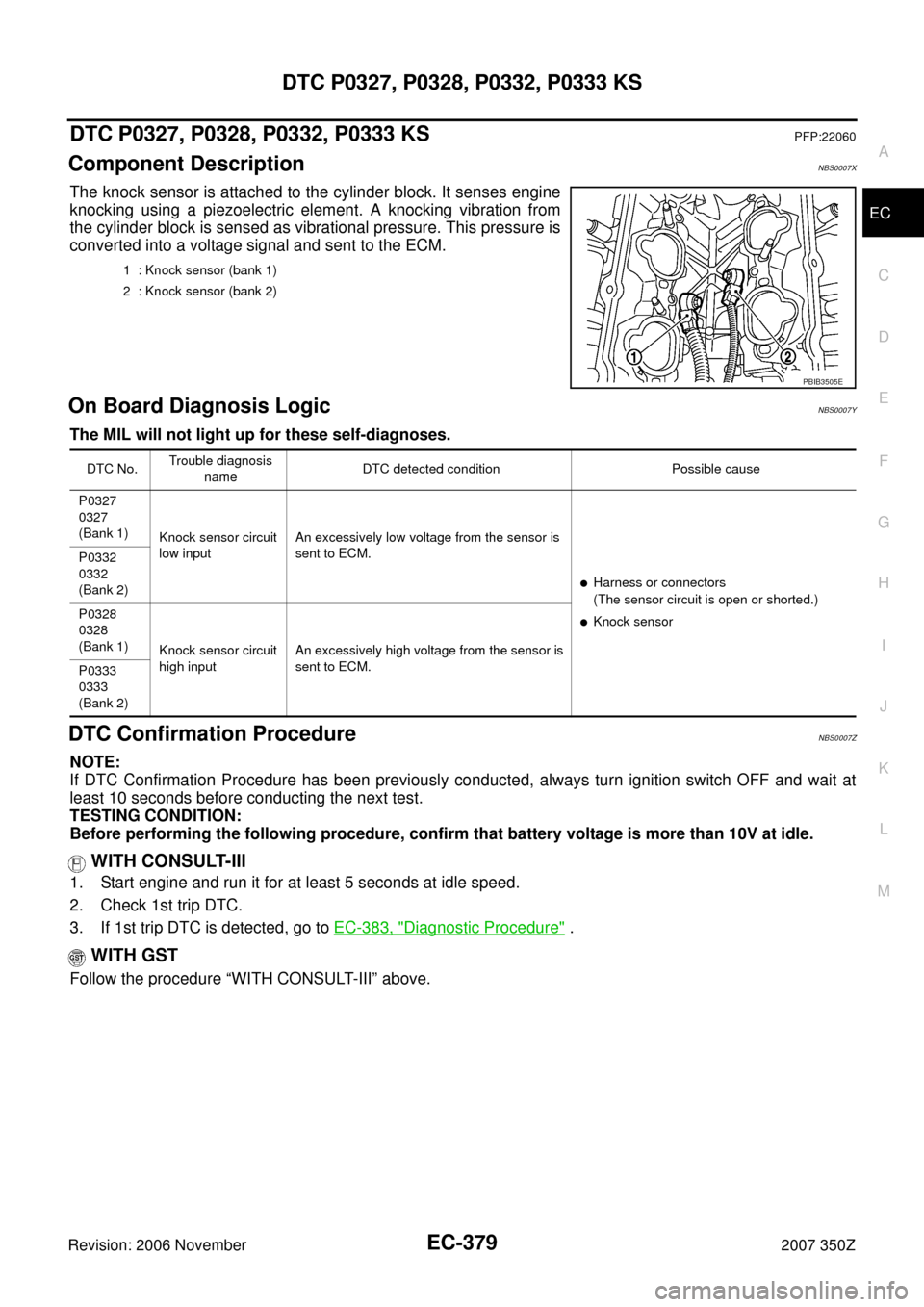
DTC P0327, P0328, P0332, P0333 KS
EC-379
C
D
E
F
G
H
I
J
K
L
MA
EC
Revision: 2006 November2007 350Z
DTC P0327, P0328, P0332, P0333 KSPFP:22060
Component DescriptionNBS0007X
The knock sensor is attached to the cylinder block. It senses engine
knocking using a piezoelectric element. A knocking vibration from
the cylinder block is sensed as vibrational pressure. This pressure is
converted into a voltage signal and sent to the ECM.
On Board Diagnosis LogicNBS0007Y
The MIL will not light up for these self-diagnoses.
DTC Confirmation ProcedureNBS0007Z
NOTE:
If DTC Confirmation Procedure has been previously conducted, always turn ignition switch OFF and wait at
least 10 seconds before conducting the next test.
TESTING CONDITION:
Before performing the following procedure, confirm that battery voltage is more than 10V at idle.
WITH CONSULT-III
1. Start engine and run it for at least 5 seconds at idle speed.
2. Check 1st trip DTC.
3. If 1st trip DTC is detected, go to EC-383, "
Diagnostic Procedure" .
WITH GST
Follow the procedure “WITH CONSULT-III” above.
1 : Knock sensor (bank 1)
2 : Knock sensor (bank 2)
PBIB3505E
DTC No.Trouble diagnosis
nameDTC detected condition Possible cause
P0327
0327
(Bank 1)
Knock sensor circuit
low inputAn excessively low voltage from the sensor is
sent to ECM.
�Harness or connectors
(The sensor circuit is open or shorted.)
�Knock sensor P0332
0332
(Bank 2)
P0328
0328
(Bank 1)
Knock sensor circuit
high inputAn excessively high voltage from the sensor is
sent to ECM.
P0333
0333
(Bank 2)
Page 383 of 720
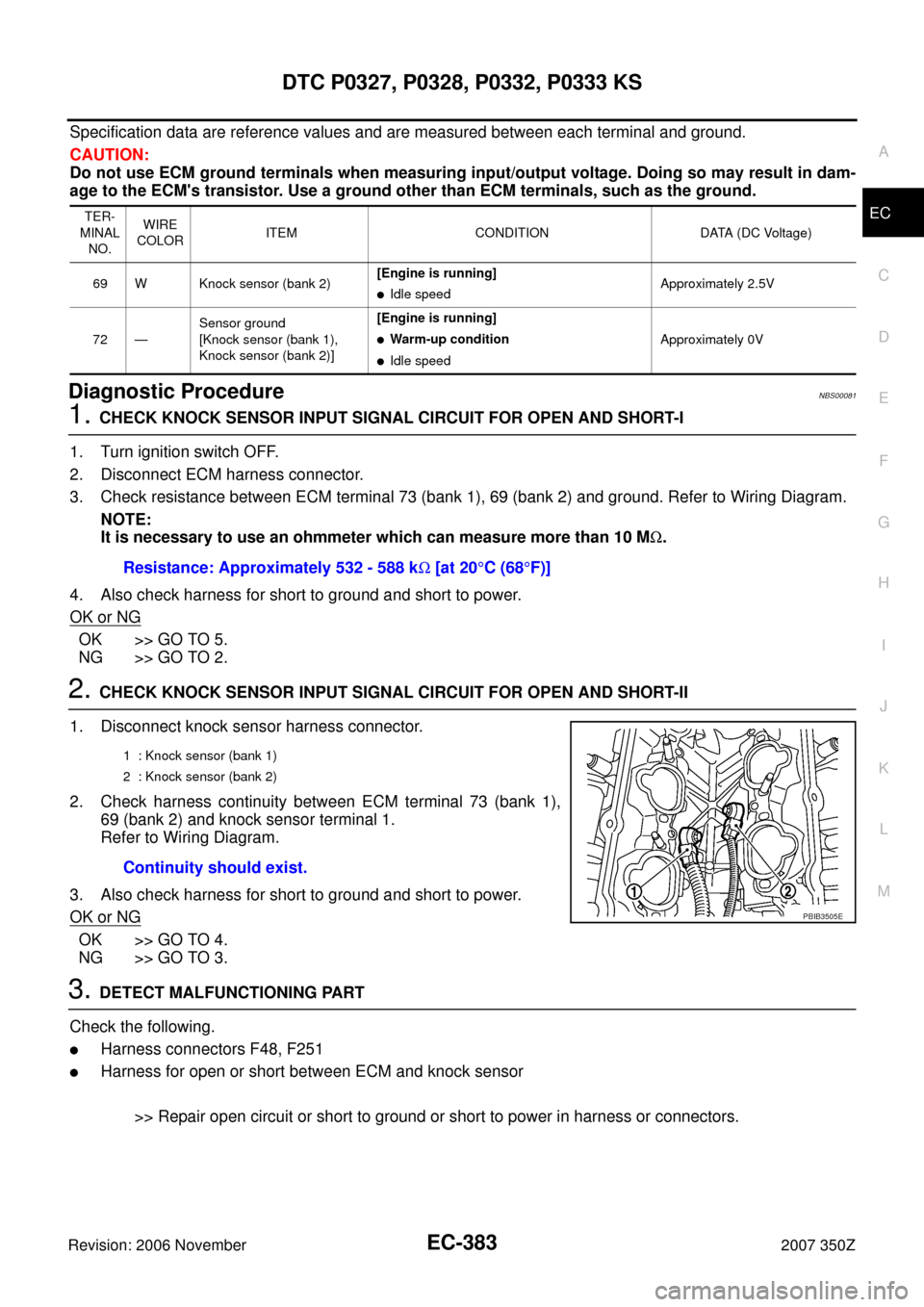
DTC P0327, P0328, P0332, P0333 KS
EC-383
C
D
E
F
G
H
I
J
K
L
MA
EC
Revision: 2006 November2007 350Z
Specification data are reference values and are measured between each terminal and ground.
CAUTION:
Do not use ECM ground terminals when measuring input/output voltage. Doing so may result in dam-
age to the ECM's transistor. Use a ground other than ECM terminals, such as the ground.
Diagnostic ProcedureNBS00081
1. CHECK KNOCK SENSOR INPUT SIGNAL CIRCUIT FOR OPEN AND SHORT-I
1. Turn ignition switch OFF.
2. Disconnect ECM harness connector.
3. Check resistance between ECM terminal 73 (bank 1), 69 (bank 2) and ground. Refer to Wiring Diagram.
NOTE:
It is necessary to use an ohmmeter which can measure more than 10 MΩ.
4. Also check harness for short to ground and short to power.
OK or NG
OK >> GO TO 5.
NG >> GO TO 2.
2. CHECK KNOCK SENSOR INPUT SIGNAL CIRCUIT FOR OPEN AND SHORT-II
1. Disconnect knock sensor harness connector.
2. Check harness continuity between ECM terminal 73 (bank 1),
69 (bank 2) and knock sensor terminal 1.
Refer to Wiring Diagram.
3. Also check harness for short to ground and short to power.
OK or NG
OK >> GO TO 4.
NG >> GO TO 3.
3. DETECT MALFUNCTIONING PART
Check the following.
�Harness connectors F48, F251
�Harness for open or short between ECM and knock sensor
>> Repair open circuit or short to ground or short to power in harness or connectors.
TER-
MINAL
NO.WIRE
COLORITEM CONDITION DATA (DC Voltage)
69 W Knock sensor (bank 2)[Engine is running]
�Idle speedApproximately 2.5V
72 —Sensor ground
[Knock sensor (bank 1),
Knock sensor (bank 2)][Engine is running]
�Warm-up condition
�Idle speedApproximately 0V
Resistance: Approximately 532 - 588 kΩ [at 20°C (68°F)]
1 : Knock sensor (bank 1)
2 : Knock sensor (bank 2)
Continuity should exist.
PBIB3505E
Page 387 of 720
DTC P0335 CKP SENSOR (POS)
EC-387
C
D
E
F
G
H
I
J
K
L
MA
EC
Revision: 2006 November2007 350Z
DTC Confirmation ProcedureNBS00087
NOTE:
If DTC Confirmation Procedure has been previously conducted, always turn ignition switch OFF and wait at
least 10 seconds before conducting the next test.
TESTING CONDITION:
Before performing the following procedure, confirm that battery voltage is more than 10.5V with igni-
tion switch ON.
WITH CONSULT-III
1. Crank engine for at least 2 seconds and run it for at least 5 seconds at idle speed.
2. Check 1st trip DTC.
3. If 1st trip DTC is detected, go to EC-390, "
Diagnostic Procedure" .
WITH GST
Follow the procedure “WITH CONSULT-III” above.
Page 396 of 720
EC-396
DTC P0340, P0345 CMP SENSOR (PHASE)
Revision: 2006 November2007 350Z
DTC Confirmation ProcedureNBS0008F
NOTE:
If DTC Confirmation Procedure has been previously conducted, always turn ignition switch OFF and wait at
least 10 seconds before conducting the next test.
TESTING CONDITION:
Before performing the following procedure, confirm that battery voltage is more than 10.5V with igni-
tion switch ON.
WITH CONSULT-III
1. Crank engine for at least 2 seconds and run it for at least 5 seconds at idle speed.
2. Check 1st trip DTC.
3. If 1st trip DTC is detected, go to EC-400, "
Diagnostic Procedure" .
If 1st trip DTC is not detected, go to next step.
4. Maintaining engine speed at more than 800 rpm for at least 5 seconds.
5. Check 1st trip DTC.
6. If 1st trip DTC is detected, go to EC-400, "
Diagnostic Procedure" .
WITH GST
Follow the procedure “WITH CONSULT-III” above.
Page 400 of 720
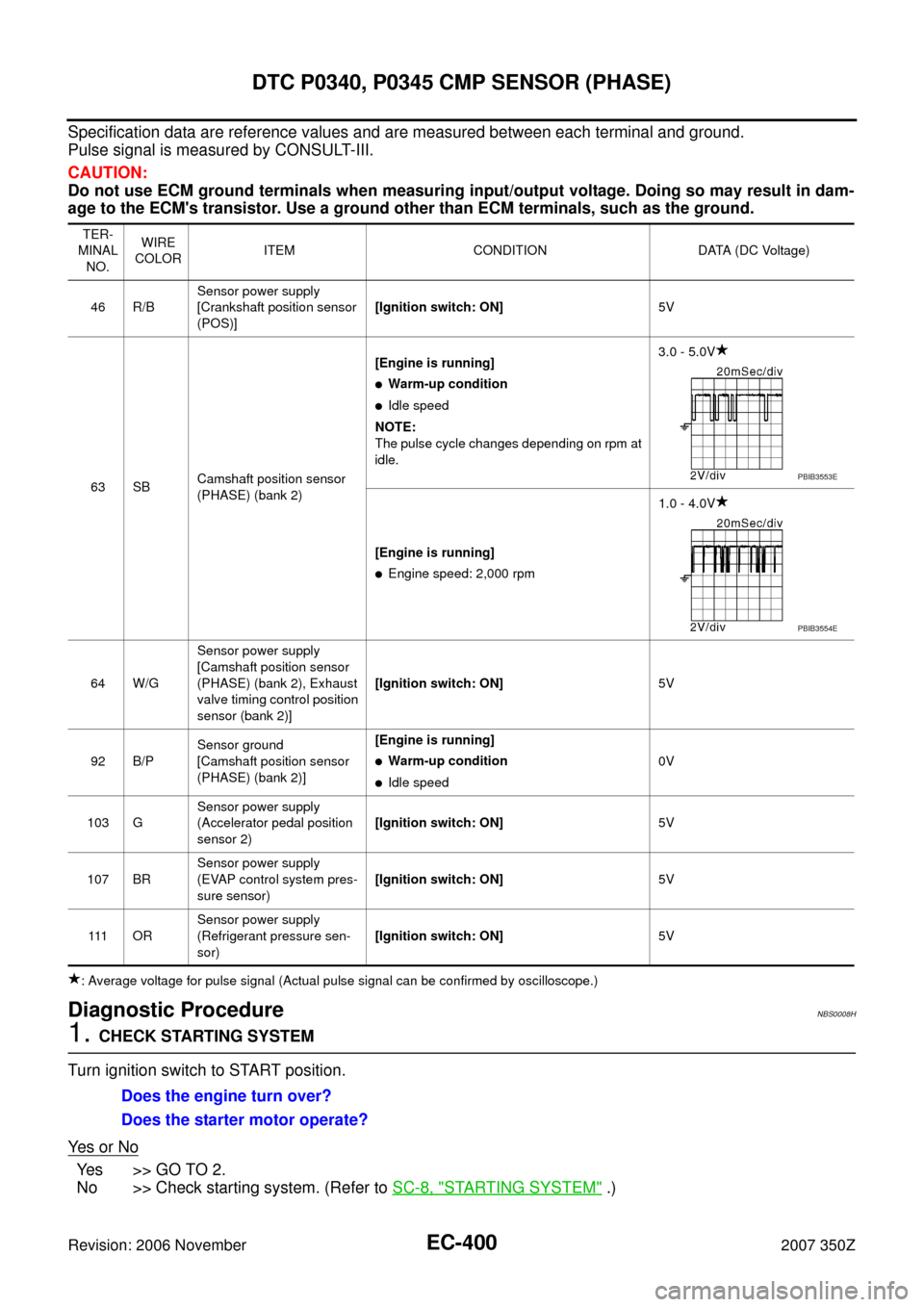
EC-400
DTC P0340, P0345 CMP SENSOR (PHASE)
Revision: 2006 November2007 350Z
Specification data are reference values and are measured between each terminal and ground.
Pulse signal is measured by CONSULT-III.
CAUTION:
Do not use ECM ground terminals when measuring input/output voltage. Doing so may result in dam-
age to the ECM's transistor. Use a ground other than ECM terminals, such as the ground.
: Average voltage for pulse signal (Actual pulse signal can be confirmed by oscilloscope.)
Diagnostic ProcedureNBS0008H
1. CHECK STARTING SYSTEM
Turn ignition switch to START position.
Ye s o r N o
Yes >> GO TO 2.
No >> Check starting system. (Refer to SC-8, "
STARTING SYSTEM" .)
TER-
MINAL
NO.WIRE
COLORITEM CONDITION DATA (DC Voltage)
46 R/BSensor power supply
[Crankshaft position sensor
(POS)][Ignition switch: ON]5V
63 SBCamshaft position sensor
(PHASE) (bank 2)[Engine is running]
�Warm-up condition
�Idle speed
NOTE:
The pulse cycle changes depending on rpm at
idle.3.0 - 5.0V
[Engine is running]
�Engine speed: 2,000 rpm1.0 - 4.0V
64 W/GSensor power supply
[Camshaft position sensor
(PHASE) (bank 2), Exhaust
valve timing control position
sensor (bank 2)][Ignition switch: ON]5V
92 B/PSensor ground
[Camshaft position sensor
(PHASE) (bank 2)][Engine is running]
�Warm-up condition
�Idle speed0V
103 GSensor power supply
(Accelerator pedal position
sensor 2)[Ignition switch: ON]5V
107 BRSensor power supply
(EVAP control system pres-
sure sensor)[Ignition switch: ON]5V
111 O RSensor power supply
(Refrigerant pressure sen-
sor)[Ignition switch: ON]5V
PBIB3553E
PBIB3554E
Does the engine turn over?
Does the starter motor operate?
Page 407 of 720
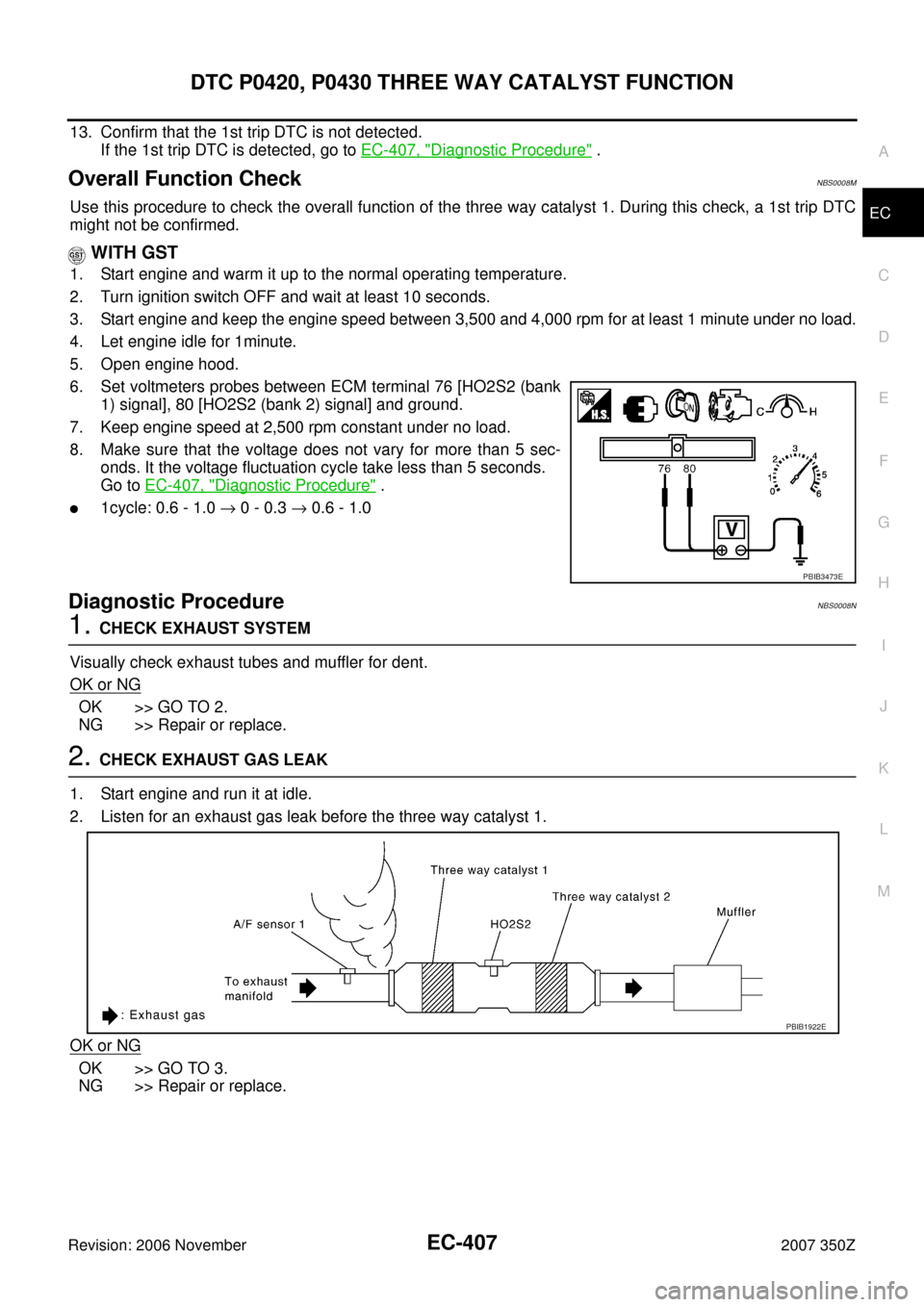
DTC P0420, P0430 THREE WAY CATALYST FUNCTION
EC-407
C
D
E
F
G
H
I
J
K
L
MA
EC
Revision: 2006 November2007 350Z
13. Confirm that the 1st trip DTC is not detected.
If the 1st trip DTC is detected, go to EC-407, "
Diagnostic Procedure" .
Overall Function CheckNBS0008M
Use this procedure to check the overall function of the three way catalyst 1. During this check, a 1st trip DTC
might not be confirmed.
WITH GST
1. Start engine and warm it up to the normal operating temperature.
2. Turn ignition switch OFF and wait at least 10 seconds.
3. Start engine and keep the engine speed between 3,500 and 4,000 rpm for at least 1 minute under no load.
4. Let engine idle for 1minute.
5. Open engine hood.
6. Set voltmeters probes between ECM terminal 76 [HO2S2 (bank
1) signal], 80 [HO2S2 (bank 2) signal] and ground.
7. Keep engine speed at 2,500 rpm constant under no load.
8. Make sure that the voltage does not vary for more than 5 sec-
onds. It the voltage fluctuation cycle take less than 5 seconds.
Go to EC-407, "
Diagnostic Procedure" .
�1cycle: 0.6 - 1.0 → 0 - 0.3 → 0.6 - 1.0
Diagnostic ProcedureNBS0008N
1. CHECK EXHAUST SYSTEM
Visually check exhaust tubes and muffler for dent.
OK or NG
OK >> GO TO 2.
NG >> Repair or replace.
2. CHECK EXHAUST GAS LEAK
1. Start engine and run it at idle.
2. Listen for an exhaust gas leak before the three way catalyst 1.
OK or NG
OK >> GO TO 3.
NG >> Repair or replace.
PBIB3473E
PBIB1922E
Page 408 of 720
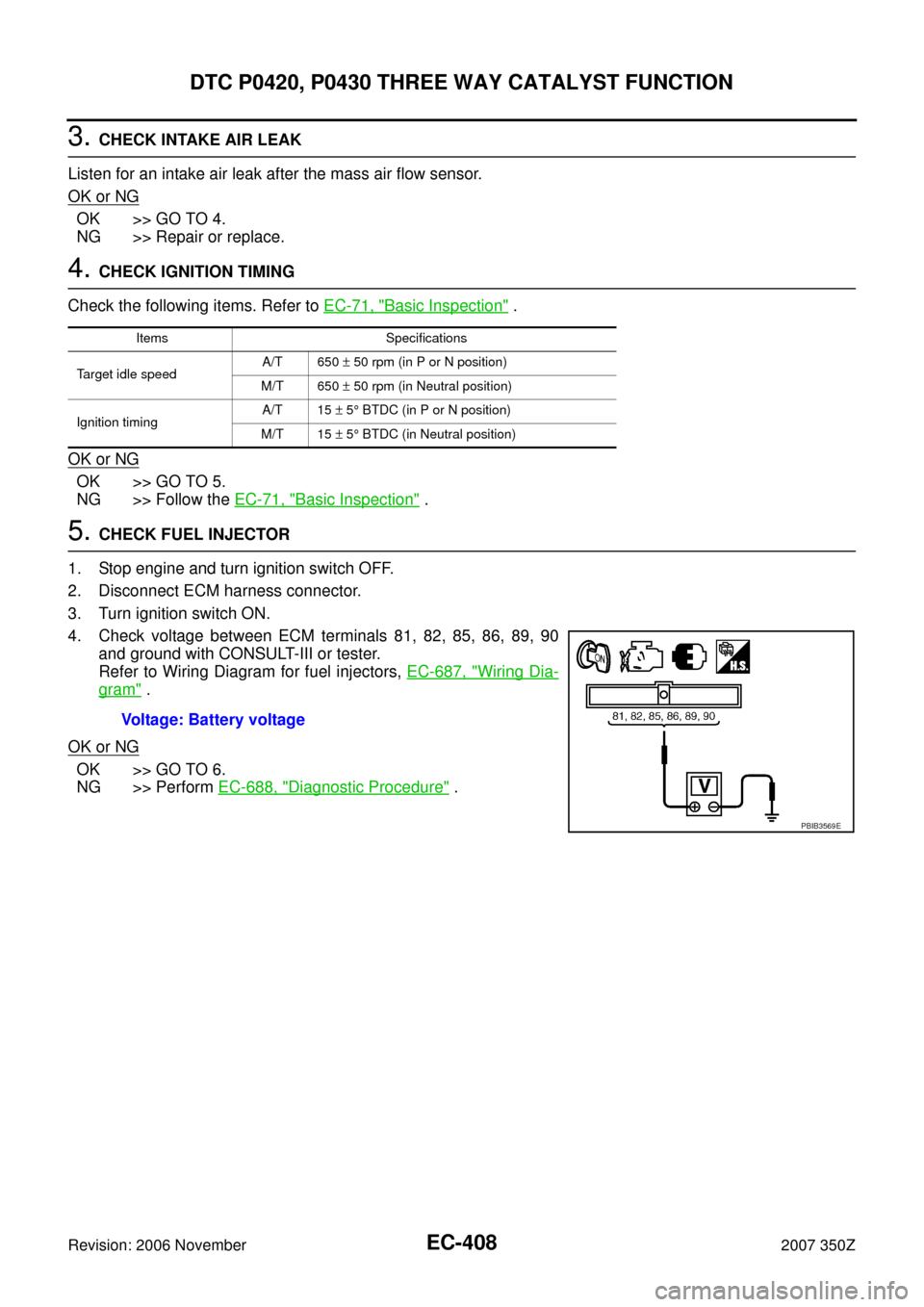
EC-408
DTC P0420, P0430 THREE WAY CATALYST FUNCTION
Revision: 2006 November2007 350Z
3. CHECK INTAKE AIR LEAK
Listen for an intake air leak after the mass air flow sensor.
OK or NG
OK >> GO TO 4.
NG >> Repair or replace.
4. CHECK IGNITION TIMING
Check the following items. Refer to EC-71, "
Basic Inspection" .
OK or NG
OK >> GO TO 5.
NG >> Follow the EC-71, "
Basic Inspection" .
5. CHECK FUEL INJECTOR
1. Stop engine and turn ignition switch OFF.
2. Disconnect ECM harness connector.
3. Turn ignition switch ON.
4. Check voltage between ECM terminals 81, 82, 85, 86, 89, 90
and ground with CONSULT-III or tester.
Refer to Wiring Diagram for fuel injectors, EC-687, "
Wiring Dia-
gram" .
OK or NG
OK >> GO TO 6.
NG >> Perform EC-688, "
Diagnostic Procedure" .
Items Specifications
Target idle speedA/T 650 ± 50 rpm (in P or N position)
M/T 650 ± 50 rpm (in Neutral position)
Ignition timingA/T 15 ± 5° BTDC (in P or N position)
M/T 15 ± 5° BTDC (in Neutral position)
Voltage: Battery voltage
PBIB3569E
Page 409 of 720
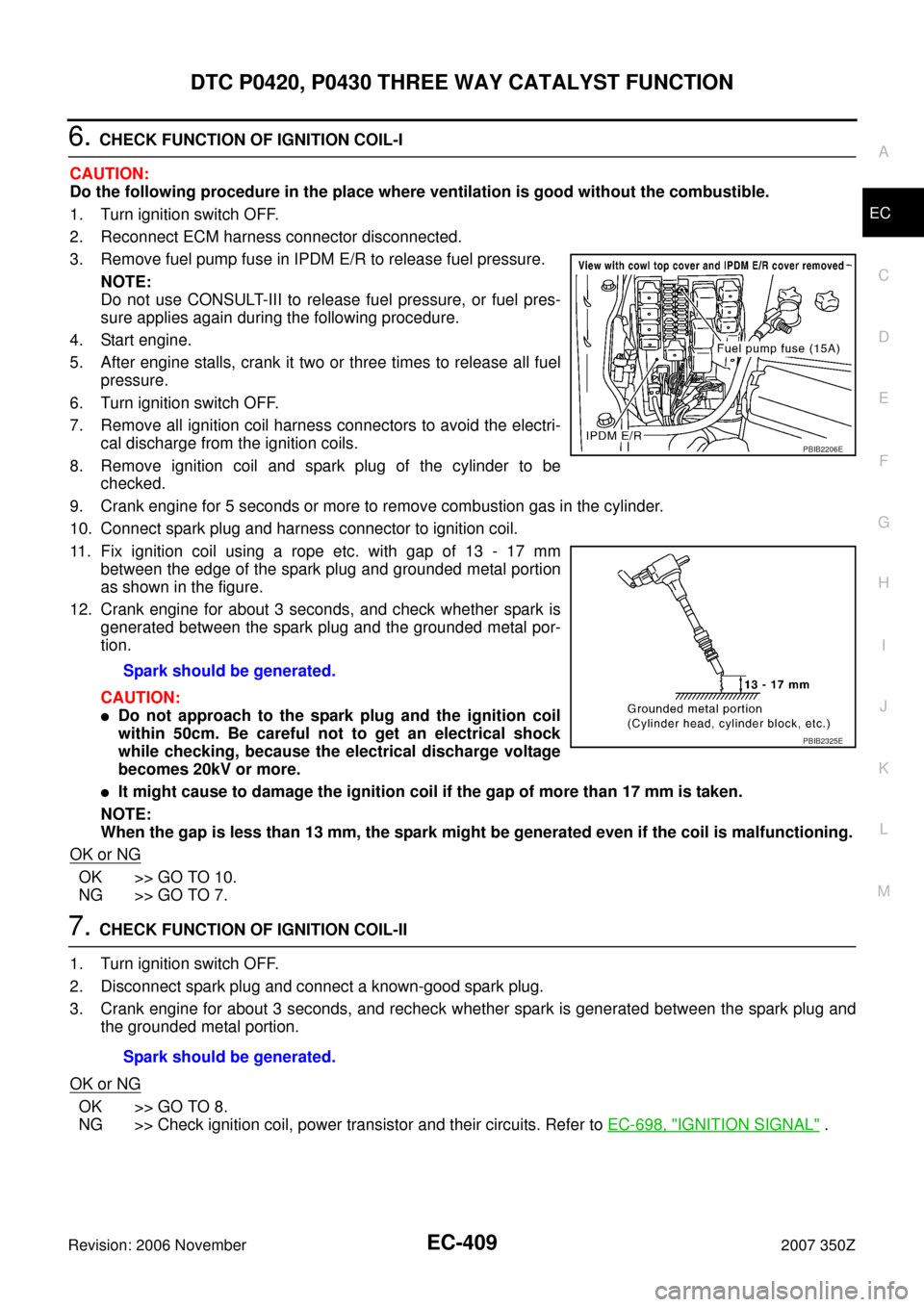
DTC P0420, P0430 THREE WAY CATALYST FUNCTION
EC-409
C
D
E
F
G
H
I
J
K
L
MA
EC
Revision: 2006 November2007 350Z
6. CHECK FUNCTION OF IGNITION COIL-I
CAUTION:
Do the following procedure in the place where ventilation is good without the combustible.
1. Turn ignition switch OFF.
2. Reconnect ECM harness connector disconnected.
3. Remove fuel pump fuse in IPDM E/R to release fuel pressure.
NOTE:
Do not use CONSULT-III to release fuel pressure, or fuel pres-
sure applies again during the following procedure.
4. Start engine.
5. After engine stalls, crank it two or three times to release all fuel
pressure.
6. Turn ignition switch OFF.
7. Remove all ignition coil harness connectors to avoid the electri-
cal discharge from the ignition coils.
8. Remove ignition coil and spark plug of the cylinder to be
checked.
9. Crank engine for 5 seconds or more to remove combustion gas in the cylinder.
10. Connect spark plug and harness connector to ignition coil.
11. Fix ignition coil using a rope etc. with gap of 13 - 17 mm
between the edge of the spark plug and grounded metal portion
as shown in the figure.
12. Crank engine for about 3 seconds, and check whether spark is
generated between the spark plug and the grounded metal por-
tion.
CAUTION:
�Do not approach to the spark plug and the ignition coil
within 50cm. Be careful not to get an electrical shock
while checking, because the electrical discharge voltage
becomes 20kV or more.
�It might cause to damage the ignition coil if the gap of more than 17 mm is taken.
NOTE:
When the gap is less than 13 mm, the spark might be generated even if the coil is malfunctioning.
OK or NG
OK >> GO TO 10.
NG >> GO TO 7.
7. CHECK FUNCTION OF IGNITION COIL-II
1. Turn ignition switch OFF.
2. Disconnect spark plug and connect a known-good spark plug.
3. Crank engine for about 3 seconds, and recheck whether spark is generated between the spark plug and
the grounded metal portion.
OK or NG
OK >> GO TO 8.
NG >> Check ignition coil, power transistor and their circuits. Refer to EC-698, "
IGNITION SIGNAL" . Spark should be generated.
PBIB2206E
PBIB2325E
Spark should be generated.